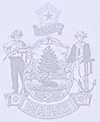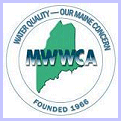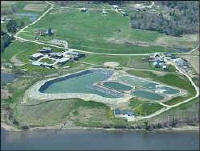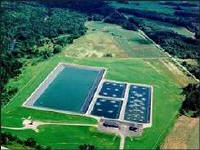|












2003
Maine Wastewater Salary Survey as conducted by the Maine Wastewater Control
Association

2003 Maine
Wastewater Rate Survey conducted by the Maine Rural
Water Association

Maine DEP Monthly
O & M Newsletter
Maine and WEF's
Operation Forum
Penobscot Watershed and Development of a TMDL
EPA Binational Toxics
Strategy
Maine Rural Water
Association
Maine Wastewater
Operator Certification
Guide
Maine Is Technology
Newsletter
Maine
Wastewater Control Association

Maine
Wastewater Engineering
Firms
| |
|
Troubleshooting
Aerated Lagoons
PROBLEMS
| PROBLEM |
POSSIBLE CAUSES |
POSSIBLE SOLUTIONS |
|
Odors |
Organic Overload
Poor Aeration or Mixing
Previous Ice Covered Lagoons
Duckweed Growth
Excess weed growth on lagoon
banks harboring flies, and mosquitoes, trapping grease and
organics |
Increase aeration capacity
Alter aerator run time, change or
supplement type of aeration
Increase aerator run time, change
type of aerator to eliminate ice cover
Increase aerator run time,
chemical treatment (DiQuat), physical removal (harvest), add ducks
or geese
Physical removal by pulling, mowing, burning, or chemical
treatment (Diquat). In winter, lower pond level and allow ice to
freeze around weed stem. Increase water level.
|

| PROBLEM |
POSSIBLE CAUSES |
POSSIBLE SOLUTIONS |
|
Poor BOD Removal |
Organic Overloading
Short Circuiting
Ice Covered Lagoons
Recent Reduction in Lagoon
Temperature
Algal Bloom |
Increase Aeration Capacity
Improve inlet-outlet conditions,
add baffles, add recirculation to improve mixing, add or improve
aeration of lagoons
Change or add aerator
Increase hydraulic detention time
Increase mechanical mixing, add physical shade (Aquasahde,
Photoblue), floating cover such as swimming pool cover, styrofaom
sheets or balls, duckweed cover, addition of algal predator such
as Daphnia, add chemicals (copper sulfate), addition of
constructed wetlands to polish effluent.
|

| PROBLEM |
POSSIBLE CAUSES |
POSSIBLE SOLUTIONS |
|
High Effluent T.S.S. |
Algal Bloom
Excess Lagoon Mixing or Short Circuiting
Spring or Fall Turnover
Excessive Solids Build Up in
Bottoms of Lagoons |
See algal bloom
solution in previous section
See short circuiting solution in
previous section
Add different types of aeration
to eliminate stratification or add supplemental aeration, add
recirculation
Physically remove solids by pumping or sludge barge; proper sludge
disposal in conformance with State and Federal regulations
|

| PROBLEM |
POSSIBLE CAUSES |
POSSIBLE SOLUTIONS |
|
Poor Fecal Coliform
Removal |
Chlorine Residual too low or
poor chlorine contact chamber design
Increase in chlorine demanding
substance in effluent (H2S1, NO2)
Water Fowl Contamination
|
Increase chlorine
feed rate, provide 40:1 l:w ratio, provide a minimum 30 minute
detention time at peak flow
Remove solids from chlorine
contact chamber, increase chlorine feed rate
Increase chlorine feed rate
|

| PROBLEM |
POSSIBLE CAUSES |
POSSIBLE SOLUTIONS |
|
High pH |
Algal Stripping of CO2 and
Bicarbonate Alkalinity |
See algal bloom solution
above |

| PROBLEM |
POSSIBLE CAUSES |
POSSIBLE SOLUTIONS |
|
Low pH |
Accumulation of organic sludge
stuck in the "acid phase"
Extensive nitrification
Organic Overloading
Excessive Daphnia Growth |
Physically remove sludge by
pumping or sludge dredge
Increase aerator run time, add
recirculation
Increase aeration capacity, add
recirculation
Increase aeration capacity or run time
|

|
|
|

